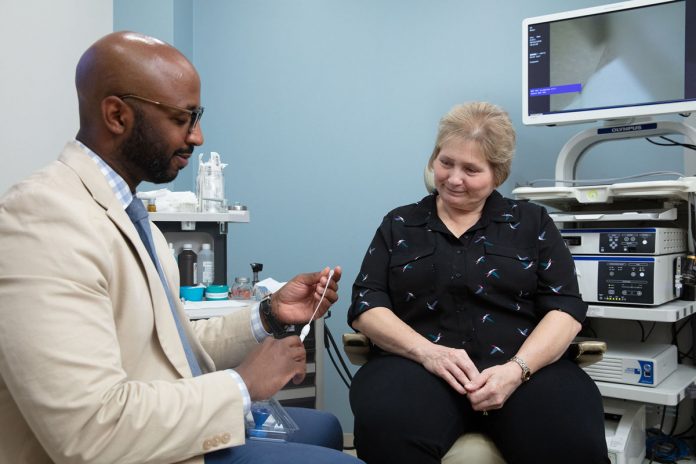Cutting-edge, non-surgical treatment at OU Medicine targets chronic stuffy nose
An Oklahoma woman is one of the first patients outside of a clinical trial to experience the benefits of a new, non-surgical treatment for her chronic stuffy nose.
Most of us have experienced a head cold so bad that it leaves you so stuffed up you can no longer breathe through your nose. For Denise Crozier, 56, it wasn’t a cold causing her chronic stuffed up nose or the pain and pressure that accompanied it. The Oklahoma City woman suffered from nasal polyps, soft, non-cancerous growths on the lining of the nose or sinuses.
“When you get a lot of inflammation, the lining of the nose becomes very swollen and redundant, and it forms a round structure that basically fills the nasal cavity,” explained Dr. Kibwei McKinney, an ear, nose and throat specialist with OU Medicine.
Surgery had been the first line of defense for patients like Crozier for whom treatment with oral steroids has failed.
“I had four surgeries in Seattle before moving to Oklahoma, and then since I have been here, I’ve had three,” Crozier said.
Each time, the surgery would initially bring relief, but before she knew it, the polyps would be back.
“Each time, she got some temporary relief, but almost like clockwork, it would come back and she would have a return of her symptoms,” McKinney said.
This time, though, McKinney returned from a recent conference with a new treatment option for Crozier a newly-approved, non-surgical treatment. It utilizes a tiny sinus implant. He explained to her that it could be placed without pain during a visit to his office at OU Medicine.
The implant is a small teardrop-shaped device that when deployed appears a bit like a badminton birdie. It’s placed under the guidance of an endoscope.
“I actually have a camera and scope that I look through to see the anatomical structures and then I place the splint with minimal discomfort,” McKinney said. “It basically stints open the cavity and then over time it treats the surrounding tissue with steroids, which are very effective at controlling polyp growth. As the steroid is leached out, the polyps occupying the space begin to melt away and the pressure associated with them also goes away.”
As a nurse, Crozier did her homework and quickly realized that this treatment could offer relief and save her from another trip to the operating room.
“Anything to keep me out of the OR is fantastic,” she remarked.
The device was placed quickly and without pain during an office visit with McKinney.
“They numbed me up, so I really didn’t feel a thing,” Crozier said.
After several months, she returned to McKinney’s office to have the device removed; and just as it had gone into place under endoscopic guidance, it also was removed that way in just a matter of seconds.
Crozier’s eyes watered just a bit, but she said there was no pain and the relief she has experienced has been incredible.
“It’s wide open in there. There are no polyps or anything. It works. It’s great,” she exclaimed, adding that she would easily recommend the procedure to anyone else facing the same battle she has faced with nasal polyps.
Specialists at OU Medicine say the new treatment provides a valuable option for patients unable to take oral steroids, as well as for those who are not good candidates for surgery or for whom repeated surgeries have failed to bring relief.














